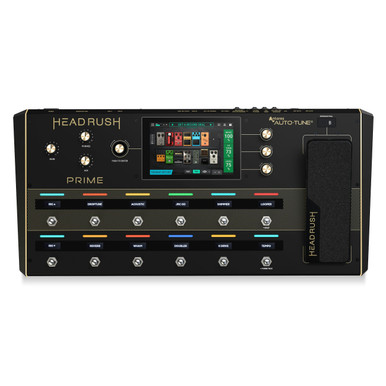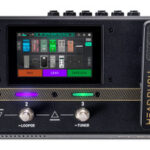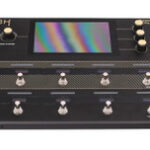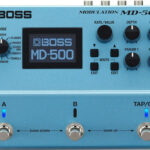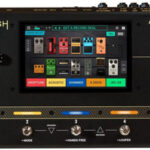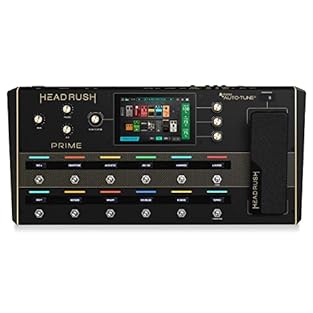Description
HeadRush Guitar Pedals are fresh in, this is a New one & the Just Pedals team think it is a very nice one too. Good news ! This can be delivered straight to your door, quickly and securely, anywhere in the UK & Europe. For more info on this New Guitar Pedals, please read on for full details, demos, videos, reviews and order online.
Featuring an advanced multi-core processor with a huge library of onboard guitar FX, amp, cab and microphone emulations, as well as smart amp/pedal cloning and IR loading, a best-in-class looper, and a full suite of vocal FX (including the industry-standard Antares Auto-Tune) — the HeadRush Prime is easily one of the most powerful, versatile, and realistic-sounding floorboard FX processors ever made!
HeadRush 5.0 Software Update
One of the best things about HeadRush gear? It doesn’t just sound amazing out of the box — it keeps getting better. Regular updates mean your tones and performances are always levelling up. And the 5.0 Software Update is a big one. Here’s what’s in store:
- Built-in Drum Machine: 16 pro kits and 134 styles across 15 genres, crafted by the legendary sound designers from Alesis Drums & BFD. Enjoy foot-switchable fills, transitions and accents for dynamic performances. Plus, customisable Mix, EQ, Timbre and Groove controls for the perfect sound and feel. Even looper features work with it, so you can build ever greater looped performances.
- TIDAL Integration: Load any of TIDAL’s 110 million songs straight to the Practice Tool. Loop tricky sections, slow down fast passages without changing pitch and even transpose tracks without messing with the tempo. It’s perfect for learning your favourite riffs or nailing that solo.
- New Amps & FX: Play through 3 new ReValver amps (25 ON-1 Clean, Crunch & Lead), 2 new boutique overdrives (Jimmy OD and Palace OD), plus new and improved pitch FX (Up-Tune, Drop-Tune & Vocal Harmony).
But that’s not all — there are loads of quality-of-life upgrades too:
- Direct HeadRush Cloud access via Wi-Fi Remote Editor, for easier rig and clone sharing.
- Auto-Engage Expression Pedal Mode for hands-free bypass.
- Block Mix parameter for precise wet/dry blend of each independent block.
- Minor UI/UX and DSP performance improvements throughout.
Key Features
- High Resolution Touchscreen – 7-inch high-resolution touchscreen with intuitive interface.
- Life-Like Modelling – Realistic and responsive amp, cabinet, and microphone modelling.
- Massive Library – Expansive library of guitar and vocal FX, including Antares Auto-Tune.
- Clone Amps & Pedals – Amp Cloner captures the sound of your favourite amp, preamp, distortion pedal, overdrive pedal, or fuzz pedal.
- Connect Via Wi-Fi – Direct Wi-Fi connection to the HeadRush Cloud for clone sharing, preset sharing, and firmware updates.
- Practice Wirelessly – Wi-Fi streaming music practice tool makes learning songs easier than ever before.
- Bluetooth Connectivity – Bluetooth audio connectivity for playing along with mobile devices.
- Gapless Preset Shifting – Powerful custom-designed multicore DSP system with gapless preset switching.
- Rugged Chassis – Road-ready steel chassis with durable built-in expression pedal and universal power supply.
- Customisable Footswitches – 12 footswitches with customizable colour LEDs and OLED scribble strip display screens.
- Endless Guitar & Bass Cabinet IRs – Import virtually unlimited guitar and bass cabinet IR files.
- Stereo FX Loop – Stereo FX loop for integrating external FX pedals and 4-cable method connectivity.
- Modern Looping Features – Best-in-class looper with save/load functionality and MIDI Sync.
- Record & Reamp – Record and re-amp via the built-in USB Audio interface (up to 24-bit/96KHz).
The high-resolution and ultra-responsive 7-inch display enables you to touch, swipe, and drag-and-drop to instantly create and edit your rigs in an unprecedentedly easy-to-use way. Housed in a road-ready steel chassis, the Prime features 12 footswitches with individual RGB indicators and OLED scribble strip displays, built-in expression pedal with toe-switch, and is packed with all the input and output connections you’ll ever need including Wi-Fi and Bluetooth audio connectivity.
The HeadRush Prime is the ultimate creative centrepiece for your setup that’s ready for the home, rehearsal, stage, or studio session. Your perfect guitar and vocal sound is literally just a touch away!
HeadRush ReValver Suite & Amp Cloner
By using the ReValver Suite software package, you are able to capture the sound of any guitar/bass amp rig, preamp or distortion pedal with ease. Create custom detailed amp/pedal models to use or choose user-made captures in the HeadRush Cloud. Once you have selected your capture, load it into the Headrush Prime, Core or Flex for instant tonal impact.
This next generation, intelligent audio cloning technology helps you create the most realistic captures of your favourite gear – you can even combine multiple clones into a superclone, which blends your favourite flavours of multiple clones to create the most expressive, head turning tone you can imagine – let your creative side flow!
Level Up Your Skills With Guitareo
The HeadRush Flex Prime includes a FREE 90-day membership to Guitareo—the world’s leading educational community for guitarists. Guitareo provides an extensive collection of courses, artist content, and more to help guitarists achieve their goals. Guitareo has content for guitarists of all levels to learn and expand their skill set from world-class musicians.
HeadRush Remote
You asked, HeadRush listened! Use the intuitive web-based editor to connect the HeadRush Core to a tablet, Mac, or PC via Wi-Fi to edit rigs and setlists on the fly.
Headrush Firmware Updates
Firmware v4.1.0 and ReValver Suite v5.1.2
- Three New Effects – C-Verb convolution reverb (50 IRs included as well as user-loadable), Multi Tap Delay (four taps with beautiful stereo spread), Grain Delay (granular delay with freeze and pitch controls)
- Deeper MIDI Controls – Footswitches, Scenes, and Rigs can send up to five messages, plus new MIDI in CC options
- Amp Cloner tweaks – Tighter low-end and gain accuracy for amps and pedals
- Improved Functionality – Per-amp Output Level control, Tuner ranges, Desktop editor enhancements
Specifications
- Display: 1 full-colour LED-backlit display with touch interface
- Footswitches: 12 with colour LEDs & OLED displays
- Pedals: 1 expression pedal
- Power Connection: IEC
- Input Voltage: 100–240 V, 50/60 Hz, 1.2 A
- Dimensions: 25.56″ x 13.414″ x 3.24″ / 64.92 x 34.13 x 8.22 cm
- Weight: 16.75 lbs. / 7.60 kg
Controls
- 300° main volume knob
- 300° phones volume knob
- 300° auxiliary volume knob
- 360° navigation/data encoder
- 360° parameter encoders (x3)
Connectors
- 1/4″ (6.35 mm) TS input (guitar)
- XLR / 1/4″ (6.35 mm) input (microphone)
- 1/4″ (6.35 mm) TRS input (expression pedal)
- 1/4″ (6.35 mm) TS input (expression pedal toe switch)
- 1/8″ (3.5 mm) stereo input (auxiliary device)
- 1/4″ (6.35 mm) TRS output (external amp footswitch)
- 1/4″ (6.35 mm) stereo pair outputs
- XLR stereo pair outputs
- 1/8″ (3.5 mm) stereo headphone output
- 1/4″ (6.35 mm) TRS input (FX send)
- 1/4″ (6.35 mm) TRS output (FX return)
- 5-pin MIDI input
- 5-pin MIDI output
- USB Type-A port
- USB Type-B port
